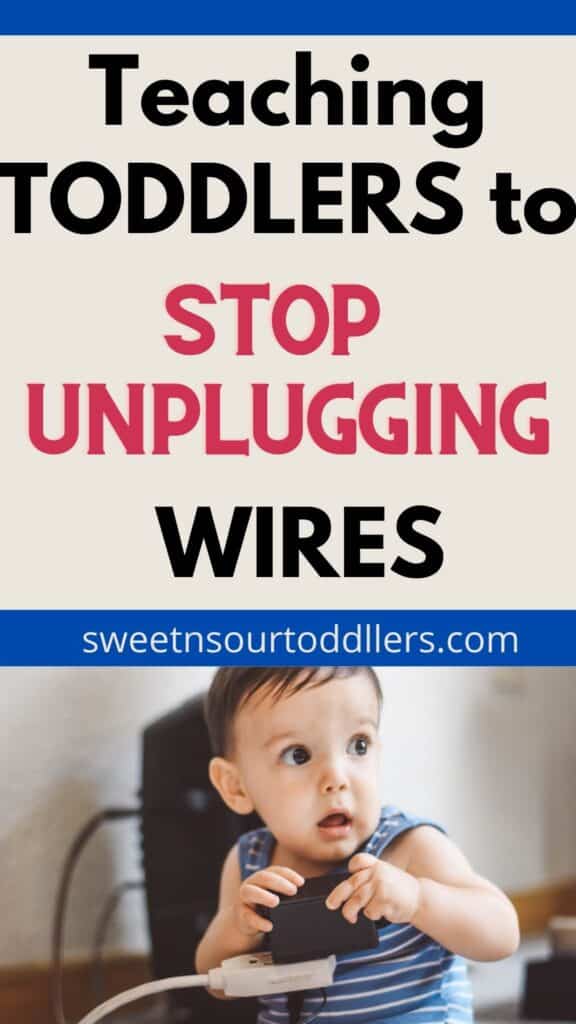Is your toddler unplugging things all day?
A large part of my day is spent trying to stop my 2 year old from doing ridiculous/dangerous things. Like flushing things down the toilet, eating crayons, drawing on walls or slamming doors. But the one that tops the list in terms of safety concerns is my toddler unplugging things.
I don’t know what it is about wires, plugs and electrical outlets… but toddlers love them. Every parent out there in the universe has pulled their hair out in frustration over their toddler’s obsession with constantly unplugging things.
And that’s because playing with cords and outlets can be extremely dangerous for little kids.
Even the simple act of plugging in or unplugging an electrical cord carries the potential of electric shock. If a child inadvertently touches the metal parts of a plug, his or her fingers could complete a short circuit that would cause a painful shock at the very least. A more serious shock could cause burns or other injury, electrocution, as well as damage to the home.
indiana electric cooperatives
Let’s look at how you can deal with this dangerous obsession while keeping your sanity intact.
How do I stop my toddler unplugging things?
The easiest way to stop your toddler from unplugging power cords is to use plug and outlet covers. These are designed to cover the entire outlet so that your child can’t access the outlet or unplug the cord. Another option is to move furniture in front of the outlet so access to the cord is blocked.
5 Ways To Stop Toddler Unplugging Things
This post contains affliliate links. As an Amazon Associate, I earn from qualifying purchases at NO additional cost to you. Thank you for your support.
1. Use Outlet Covers
Using outlet covers is the simplest way to prevent your child from yanking the plug out. There are many different types of outlet covers available in the market. These are the 3 most common outlet covers that help you effectively toddler proof your outlets (and what you should know about each of them).
1. Plastic Covers
These plastic covers have prongs and fit right into the outlet, preventing your little one from sticking things inside the outlet. These usually come in bulk and are cheap to buy. They are also easy to install and easy for adults to remove. However these will only help prevent your child from playing with the outlet. They won’t help with the unplugging issue.
2. Self Closing Covers
These are designed to replace your entire outlet cover. As the name suggests, these are self closing; as soon as a plug is taken out, the self closing cover slides over the plug holes automatically, preventing your child from inserting anything inside. Again, this would help child proof the outlet but won’t help with your unplugging issue.
3. Outlet Box Covers
Outlet box covers are designed to fit over the entire outlet (while your appliances are plugged in) and help keep out those tiny little hands. These covers not only prevent kids from inserting things inside the outlet but also prevent kids from yanking out cords or playing with them. So to deal with the unplugging issue, outlet box covers are the most effective solution. Most outlet covers are bulkier in size and work for appliances that are constantly plugged in like fridges but there are more compact outlet box covers available too.

RELATED POSTS:
The Ultimate Guide to Toddler Proofing Your Home – Safety Hacks That Work
6 Fascinating Reasons Why Toddlers Draw on Walls (And How You Can Stop Them)
Stop Toddler Turning On the Tap – 5 Brilliant Strategies
2. Move Furniture in Front of the Outlet
If you don’t want to get covers for every single electrical outlet you have in your home, another solution is to put furniture in front of the outlet.
Your room may not look as symmetrical as you’d like, but the good news is that this won’t be something you’ll have to do forever. As soon as your child is out of the toddler years you can put the furniture back where you’d like!
Note: always anchor the furniture in your home. This will help prevent it from tipping over and falling on your child
3. Toddler Proof Electrical Cords
Just think of all the things you use on an everyday basis that has a cord. There are phone charges, laptop chargers, lamps, TV, vacuum cleaner, hair dryers… the list is never ending. These are all cords that your toddler can unplug and they need to be child proofed.
Cords can be very dangerous for your curious little toddler because they can:
- wrap the cord around their neck and choke
- trip on the cord and hurt themselves
- try to chew on the cord and get an electric shock
- play with a fraying cord thats damaged
So how should a modern day family ensure that these cords aren’t being yanked out all day long?
Here are some ways you can easily and effectively child proof the cords in your home:
– Use a cord shortener: this works well for long cords. It allows you to store the excess cord inside a receptacle which your child can’t touch.
– Wrap cords together: in areas of the home where there are multiple cords together such as near the computer, you can use cord wraps. These will help to keep the cords neatly organized and prevent kids from playing with them.
– Tape cords down: for appliances constantly plugged in like refrigerators or washers, you can use tape to secure cords to the floor or even cover them up with a carpet.
– Use a cord protector: if you have a toddler (or a pet) who chews, bites, bends or plays with cords then a cord protector can be a great way to protect your cord from damage and keep your little one safe too.
Young children, particularly toddlers, experience electric shock most often when they bite into electrical cords or poke metal objects such as forks or knives into unprotected outlets or appliances.
american academy of pedeatrics
– For every day appliances like phone or laptop chargers, try to use outlets that are at a height where toddlers can’t reach.
4. Explain Dangers of Unplugging
Yes you can certainly baby proof your entire house… but what you can’t do is baby proof the whole world!
Your child will inevitably be coming into contact with electrical outlets and cords outside the house that haven’t been child proofed. So it’s important to teach your child about the dangers of electrical outlets and the consequences of misusing them.
Toddlers are old enough to understand the concept of danger and are smarter than we give them credit for.
Children are experts at getting into danger. So, how can parents help prevent the consequences? One answer, researchers say, is for parents to better understand how their children rate hazards and then use conversation to explain why certain situations can be dangerous.
science daily
For younger toddlers, have one simple word in your home that signifies the concept of danger. In our house that word is ‘hot’. (thats because my toddler would always make a grab for my boiling hot cup of tea and I used the word hot to explain the danger of touching it).
Touch the cord and make a face saying “Ouch, it’s hot” (or whatever code word you have for danger). It won’t happen overnight… But if you repeatedly teach them this then they’ll learn that cords are not for playing with and can cause them harm.
5. Reduce Opportunities to Unplug
Despite explaining the dangers of yanking out wires, your toddler will still continue to test the limits (and your patience!) a million times a day.
Thus it’s important to take steps to reduce the chance that your little one comes into contact with wires plugged in.
So whenever possible, try to:
- use the electrical outlets that are at a height which your toddler can’t reach (particularly for things you need to do often like charging your cell phone)
- avoid plugging wires in and out in front of your child
- don’t leave appliances plugged in when they’re not in use (such as a hair dryer)
- refrain from putting bright, colorful objects near electrical outlets
Always remember that even if you take all the steps above there’s nothing that can substitute supervision. Toddlers are highly unpredictable and their understanding of concepts like danger are still developing. So it’s very important to keep a sharp eye on them particularly in new places which are not child proofed.
Other posts you might enjoy:
The Ultimate Guide to Toddler Proofing Your Home – Safety Hacks That Work
15 Best Bath Toys For Toddlers That Are Educational and Fun
5 Insanely Creative Ways To Teach a Toddler to Clean Up | Cleaning With Kids
6 Fascinating Reasons Why Toddlers Draw on Walls (And How You Can Stop Them)





Leave a Reply